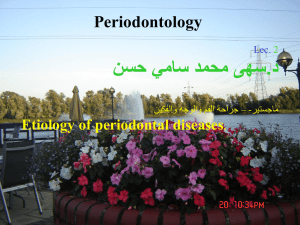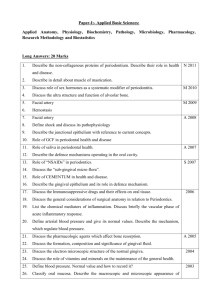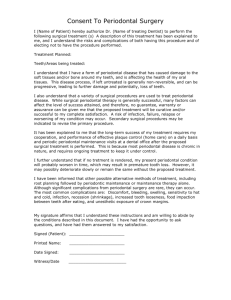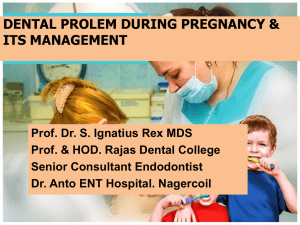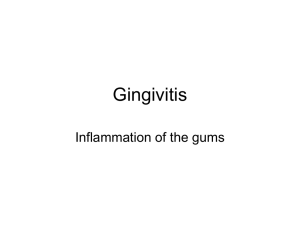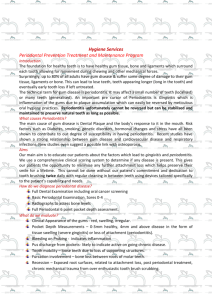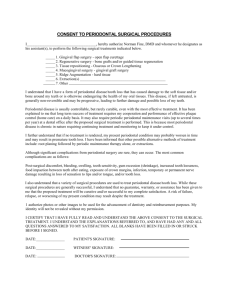Periodontal disease in children
advertisement
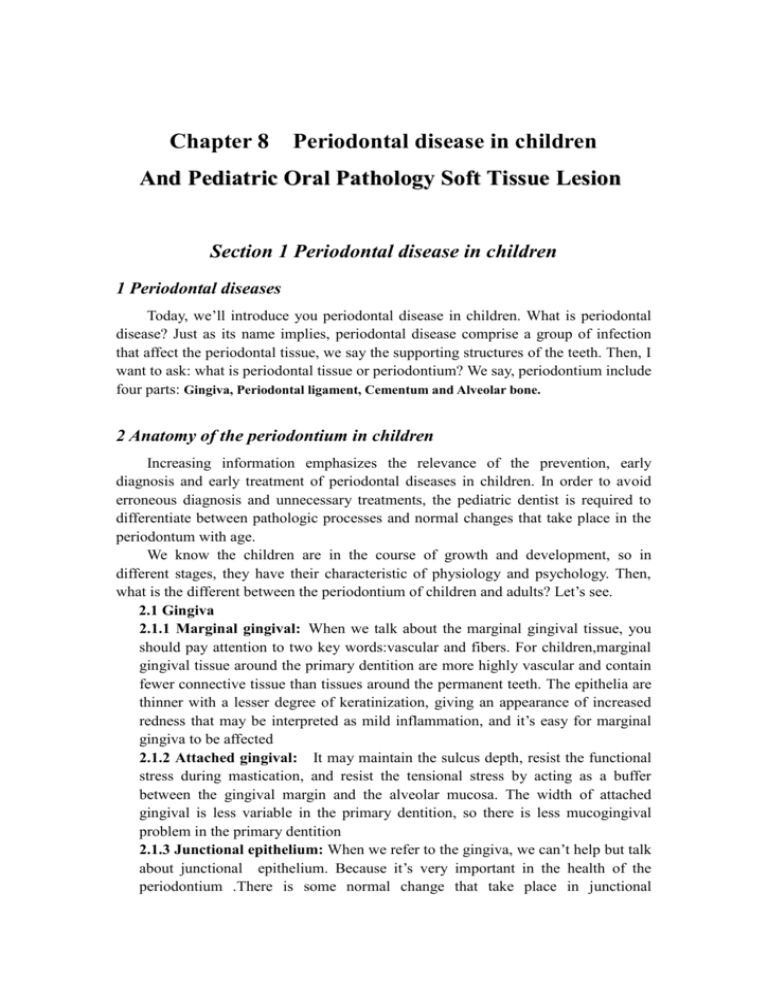
Chapter 8 Periodontal disease in children And Pediatric Oral Pathology Soft Tissue Lesion Section 1 Periodontal disease in children 1 Periodontal diseases Today, we’ll introduce you periodontal disease in children. What is periodontal disease? Just as its name implies, periodontal disease comprise a group of infection that affect the periodontal tissue, we say the supporting structures of the teeth. Then, I want to ask: what is periodontal tissue or periodontium? We say, periodontium include four parts: Gingiva, Periodontal ligament, Cementum and Alveolar bone. 2 Anatomy of the periodontium in children Increasing information emphasizes the relevance of the prevention, early diagnosis and early treatment of periodontal diseases in children. In order to avoid erroneous diagnosis and unnecessary treatments, the pediatric dentist is required to differentiate between pathologic processes and normal changes that take place in the periodontum with age. We know the children are in the course of growth and development, so in different stages, they have their characteristic of physiology and psychology. Then, what is the different between the periodontium of children and adults? Let’s see. 2.1 Gingiva 2.1.1 Marginal gingival: When we talk about the marginal gingival tissue, you should pay attention to two key words:vascular and fibers. For children,marginal gingival tissue around the primary dentition are more highly vascular and contain fewer connective tissue than tissues around the permanent teeth. The epithelia are thinner with a lesser degree of keratinization, giving an appearance of increased redness that may be interpreted as mild inflammation, and it’s easy for marginal gingiva to be affected 2.1.2 Attached gingival: It may maintain the sulcus depth, resist the functional stress during mastication, and resist the tensional stress by acting as a buffer between the gingival margin and the alveolar mucosa. The width of attached gingival is less variable in the primary dentition, so there is less mucogingival problem in the primary dentition 2.1.3 Junctional epithelium: When we refer to the gingiva, we can’t help but talk about junctional epithelium. Because it’s very important in the health of the periodontium .There is some normal change that take place in junctional epithelium and we should not treat it as disease. First, let’s see what happens during eruption of the teeth? It migrates apically. There continue to be an apical shift when the teeth are fully erupted. So the gingival margins are frequently at different levels on adjacent teeth that are at different stages of eruption. Sometimes it gives an erroneous appearance that gingival recession has occurred around those teeth that have been in the mouth longest. Stability is achieved at 12 years for 1 2 3 5 6, 16 years for the other teeth. 2.2.Periodontal ligament Periodontal ligament space is wider in children and is less fibrous and more vascular 2.3 Cementum Thinner 2.4 Alveolar bone Thinner cortical plates(皮质层) Larger marrow spaces(骨髓腔) Greater vascularity Fewer trabeculae *Clinical significance of the anatomy: Enhance the rate of progression of periodontal disease 3 A classification of periodontal disease in children 3.1Gingival conditions Acute gingivitis Chronic gingivitis Gingival overgrowth Factitious(自伤性)gingivitis Mucogingival problems 3.2 Periodontal conditions Chronic periodontitis Early-onset periodontitis Prepubertal(青春期前的) periodontitis associated with systemic disease 4 Acute gingivitis 4.1 Primary herpetic gingivostomatitis(原发性疱疹性龈口炎) 4.1.1 Definition: An acute infectious disease of the gingiva caused by the herpesvirus 4.1.2 Pathogeny: Herpes simplex viruses (HSVs)( 单 纯 疱 疹 病 毒 ) Herpes simplex viruses (HSVs) are ubiquitous, extremely host-adapted pathogens that can cause a wide variety of illnesses. Two types exist: type 1 (HSV-1) and type 2 (HSV-2). Both are closely related but differ in epidemiology.Type-1 Gingivostomatitis; Type-2 Genitalia(生殖器) 4.1.3 Transmission: HSV-1 is transmitted chiefly by contact with infected saliva, Infected saliva from an adult or another child is the mode of infection. whereas HSV-2 is transmitted sexually or from a mother's genital tract infection to her newborn. 4.1.4 Prevalence: HSV infection appears to have increased worldwide in the last 2 decades, making it a major public health concern. Many primary infections are asymptomatic, Herpes simplex infections are asymptomatic in as many as 80% of patients, but symptomatic infections may be characterized by significant morbidity and recurrence. Moreover, infections can cause life-threatening complications, particularly in immunocompromised hosts. 4.1.5 Clinical features: 1) Age: 6 months to 3 years 2) Incubation period(潜伏期): 1 week 3) Prodrome: A Febrile(发烧的) illness B Headache, malaise, oral pain, mild dysphagia(吞咽困难) C Cervical lymphadenopathy(淋巴结病) 4) Symptom A Gingivitis: Gingivitis is the most striking feature,with markedly swollen, erythe-matous, friable gums B Vesicular lesions: Vesicular lesions develop on oral mucosa ,lip and tongue , can occur anywhere in the oral cavity, on the perioral skin, on the pharynx 4.1.6 Prognosis Oral lesions heal without scarring 4.1.7 Course: Acute disease lasts 5-7 days, and the symptoms subside in 2 weeks. Viral shedding from the saliva may continue for 3 weeks or more. Adults also may develop acute gingivostomatitis, but it is less severe and is associated more often with a posterior pharyngitis. 4.1.8 Diagnosis: According to Clinical features,History and age 4.1.9 Treatment: The availability of effective chemotherapy underscores that the prompt recognition of the infection and early initiation of therapy are of utmost importance in the management of the disease. The goals of treatment are to make the patient comfortable and to prevent secondary infections or worsening systemic illness. It includes: 1) Pharmacotherapy(药物疗法) : A Antiviral treatment : Overall, medical treatment of HSV revolves around specific antiviral treatment. Patients should be advised about the potential for autoinoculation if they touch the herpetic lesion and then touch a mucous membrane or an eye. Controlling autoinoculation can be a challenge if the patient is a young child. B Symptomatic treatment : In situations in which constitutional effects such as fever occur, symptomatic treatment can be used. Analgesics, such as acetaminophen, may make the patient more comfortable. Aspirin should be avoided in pediatric patients because of the possibility of Reye syndrome. Topical anesthetics and coating agents may make the patient more comfortable and may aid in the consumption of food; however, they do not speed healing. Appropriate wound care is needed, and treatment for secondary bacterial skin infections may be required. 2) Supporting treatment: A Bed rest B Soft diet C Be kept well hydrated: The patient should maintain fluid intake and a balanced diet with the use of liquid food replacement if necessary 4.1.10 Warnings to parent: A Children are highly contagious B No school, day care etc. C Sterilize eating and drinking utensils D Disease is self-limiting; 10-14 days in duration 4.2 Acute necrotizing ulcerative gingivitis(ANUG) 4.2.1 Aetiology: Broad anaerobic infection Causative organism: Fusiform bacteria , Spirochaete(螺旋体) Other Gram-negative(革兰氏阴性)anaerobic organism 4.2.2 Clinical features: A Necrosis and ulceration : Interdental papillae marginal gingival Covered by yellowish-grey pseudomembranous( 假 膜 ) slough, Acute stage enters a chronic phase after 5-7days. Recurrence of the acute condition is inevitable B Pre-existing gingivitis C Distinctive halitosis D Acute-chronic clinical course: If acute-chronic cycle continues, the marginal tissues lose their contour and appear rounded. Eventually, involve the alveolar crest 4.2.3 Treatment A Intense oral hygiene B Oxidant: hydrogen peroxide C Mechanical debridement D Metronidazole 5 Chronic gingivitis Chronic gingivitis is a common condition. In fact, gingivitis affects over 90% of the population of the United States. If treated, the prognosis for those who have gingivitis is good. Untreated, gingivitis may progress to gum disease or periodontal disease. Gingivitis is painless in the early stages, but may lead to bleeding gums and other oral problems. Bleeding gums are only one sign of gingivitis. Gums become red and swollen, teeth may become loose or may eventually fall out. Prevalence: increases steadily between the ages of 5 and 9 years, peaks at 11 years and decrease slightly with age to 15 years. Etiology: Closely associated with the amount of plaque, debris and calculus present. 5.1 Eruptive gingivitis Cause: 1)Trauma of gingiva 2) Debris and food residue Clinical feature: 1)Site: Primary teeth and the 1st permanent molar 2)Symptom: Treatment:Oral hygiene 5.2 Filth gingivtis(不洁性龈炎) Cause: Clinical feature: Age: 3Y~5Y Site:Buccal, Papi Symptom:redness, bleeding Treatment: 1)Local cleaning, antiinflection 2)Oral hygiene 5.3 Crowding gingivitis (牙列拥挤性龈炎) Cause Symptom: Redness and thickness Treatment: A: Oral hygiene B: Orthodontic treatment 5.4 Puberty gingivitis(青春发育期龈炎) Cause: Increase of sex hormones in circulating levels *sex hormones : Oestrogen( 雌 激 素 ): Increases the cellularity of tissues and provides suitable growth condition for species associated with established gingivitis Progesterone ( 黄 体 酮 ):Increases the permeability of the gingival vasculature Clinical features: Good oral hygiene, but the gum tends to bleed and hyperplasia Bad oral hygiene Treatment: 5.5 Catarrh gingivitis (卡他性龈炎) Cause:The infection of hemolytic streptococcus(溶血性链球菌感染) Clinical features: 1)Oral lesion:soft and hematose gum, but no vesicles or ulcers 2)Systemic reaction:fever,headache,myalgia, arthralgia(关节痛) Treatment: 1)Local: Rinse 2)Systemic treatment: Penicillin 6 Drug-induced gingival overgrowth 6.1 cause: Drug: Phenytoin , Cyclosporin 1) Phenytoin A An anticonvulsant used in the management of epilepsy B Rate: occur in about 50% of subjects taking the drug C Be most severe in teenagers D Associated with a deficiency of folic acid 2) Cyclosporin A An immunsuppressant drug B Rate:30% C Children: more susceptible 6.2 Clinical feature: 1) The clinical changes of drug-induced overgrowth are very similar irrespective of the drug involved. 2) The first signs of changes are seen after 3-4months of drug administration. 3) Progress: The interdental papilla become nodular before enlarging more diffusely to encroach upon the labial tissue 4) Site:The anterior part is most severely and frequently involved 5) Sypmtom: with a good standard of oral hygiene, overgrowth gingiva is pink,firm and stippled, When there is a pre-exiting gingivitis the enlarged tissues compromise an already poor standard of plaque control.the gingiva then exhibit the classical signs of gingivitis 6.3 Management 1)A strict programme of oral hygiene instruction, scaling and polishing must be implemented. 2) Severe cases of gingival overgrowth inevitably need to be surgically excised and then recontoured to procedure an architecture that allows adequate access for cleaning 3)A follow-up programe is essential to ensure a high standard of plaque control and to detect any recurrence of the overgrowth. 4)To modify or change the anticonvulsant therapy if phenytion-induced overgrowth is refractory 5)Indefinite oral care if there is no alternative. 7 Factitious gingivitis 7.1 Minor form Etiology: Rubbing or picking the gingiva using the fingernail, or from abrasive foods Management: correct the habit and remove the source of irritation 7.2 Major form The injuries are more severe and widespread , can involve the deeper periodontal tissues. Other areas of the mouth such as the lips and tongue may be involved. Extraoral injuries may be found on the scalp, limbs or face. Management A Dressing and protection of oral wounds B No lying with dentists C Psychological or psychiatric consultation 8 Chronic periodontitis A number of epidemio-logical studies have investigated the prevalence of chronic periodonditis in children. The prevalence of the study varied due to different methods of diagnosing and different cut-off value in different studies. Prevalence At 1-11%, The chronic periodontitis initiates and progresses during the early teenage years 9 Periodontal complications of orthodontic treatment • • • • • Gingivitis Gingival overgrowth Attachment and bone loss Gingival recession Trauma 10 Early-onset aggressive periodontal disease Prepubertal periodontitis: mainly influences primary dentition immediately after the teeth have erupted. It includes generalized form and localized form: Generalized form A Gingiva:fiery red,swollen,and haemorrhagic B Tissue: hyperplastic with granular(粒状的) or nodular(节结状的) proliferation C Gross deposits of plaque D Progress: extremely rapidly, primary teeth loss:3-4 years E Bone loss: may be restricted to one arch Localized form A Progresses more slowly B Bone loss affects only incisor-molar teeth C Plaque levels are low Treatment A Intense oral hygiene at frequent intervals B Antibiotic C Extraction of the teeth Section 2 Pediatric Oral Pathology Soft Tissue Lesion 1 Infection: 1.1 Viruses: 1) Herpetic infention: Primary herpes simplex infection Secondary herpes simplex infection 2) Hand, foot,mouth disease Cause: Coxsackie virus A16 Signs and symptoms Prodrome: Fever, malaise, lymphadenopathy Skin lesion : Maculopapule(斑丘疹)on the hands and feet Oral lesion: vesicles ulceration Course: 10-14 days 3) Herpangina(疱疹性咽峡炎) Cause: Coxsackie virus A4 Signs and symptoms A Light systemic reaction and prodrome B Vesicles in the tonsillar or pharyngeal region ulcers, no coalesce for large areas of ulceration C Short-lived 1.2 Bacteria 1) Staphylococcal infections impetigo 2) Streptococcal infection 3) Congenital syphilis 1.3 Fungi or protozoa(原生动物) Oral Candidiasis Candidiasis describes a group of yeastlike fungal infections involving the skin and mucous membranes. Classification of oral candidiasis 1) Acute pseudomembranous candidiasis (thrush) 2) Acute atrophic candidiasis, 3) Chronic hyperplastic candidiasis, 4) Chronic atrophic candidiasis. Acute pseudomembranous candidiasis (thrush) Pathogens: Candida albicans. It’s a harmless commensal organism, but if there is a disturbance in the oral flora or a decrease in the immune defenses, it becomes opportunistic pathogen. Transmission: Vagina or infection from breast or feeding utensil Risk Factors: Low level of Antifungals substance Deficiency of myeloperoxidase (脊髓过氧化物酶) Low secretion of saliva Clinical features Age:Neonates and infants within 6 months Oral lesion: White patches oral mucosa, tongue Lesions develop into confluent plaques that resemble milk curds and can be wiped off to reveal a raw erythematous and sometimes bleeding base. Systemic reaction Diagnosis Clinical diagnosis:Clinical features Fungal infection:Smear Candida albicans:Culture Treatment Medication 1)1%~2% NaHCO2 once 2~3h 2)0.05% Gentian violet(龙胆紫), three times daily 3)10 万 U Nystatin(制霉菌素)/ml,once 2~3h 4)Obstinate cases,100mg Amphotericin(两性霉素)/ml,4 times daily 5)Severe cases, clotrimazole(克霉唑) Assistant management Oral hygiene Sterilization 2 Traumatic Ulcers Due to trauma to the tissue • Toothbrush abrasion • Tortilla chip • Bite • External trauma-physical violence Any location Yellow ulcerated tissue with surrounding erythematous halo Painful *Riga-Feda disease Cause A Early eruption of primary incisors B Sharpness of primary incisors C Ankyloglossia Clinical features A Site: B Shape:φ C Progress: Treatment • Local management • Removal of factors • Change feeding method • Excise of Ankyloglossia * Bednar’s ulcer Cause Clinical features Treatment * Aphthous Ulcers Be often found in children One or more small ulcers The majority of aphthous ulcers in children are of the minor variety Heal within 10-14 days Treatment is often unnecessary In severe cases: topical steroids Older children: antiseptic rinses to prevent secondary infection 3 White leisions • • • • • • • • Geographic tongue Normally symptomless Some discomfort with spicy foods Areas of the tongue appear shiny and red due to loss of filiform papillae These red patches are surrounded by white margins These areas disappear before reappearing in other region of the tongue Begin Require no treatment 4 Cysts 5 Tumors


